Impact of Different Soil Solutions on the Stability and Photocatalytic Activity of Commercial Zinc Oxide Nanoparticles
IF 5.8
2区 环境科学与生态学
Q1 CHEMISTRY, MULTIDISCIPLINARY
引用次数: 0
Abstract
Zinc oxide (ZnO) nanoparticles are extensively utilized across various industries due to their versatile applications. However, the widespread use of these nanoparticles raises concerns regarding their potential release into soil environments, and also into the soil solution. Therefore, this study aims to delve into the interplay between different soil solution properties and the stability as well as photocatalytic activity of commercially available ZnO nanoparticles. It is observed that these interactions precipitate a reduction in the primary crystallite sizes of ZnO, primarily attributed to the release of Zn2+ ions under acidic conditions, and the formation of zinc complexes or hydroxides in alkaline environments. In acidic media, there is a concomitant decrease in the hydrodynamic diameter of ZnO, serving as further confirmation of Zn2+ release, which is corroborated by analytical measurements. Conversely, in alkaline mediums, the hydrodynamic diameter remains unaltered, suggesting the formation of an amorphous layer on the nanoparticle surface in such conditions. Further analyses into the surface chemistry of ZnO nanoparticles reveal the adsorption of various organic substances onto their surfaces. These organic compounds potentially function as electron traps or occupy active sites, however, after the interaction with soil solutions, the material was still able to degrade the model pollutant. So, the interaction with soil solutions reduced the activity, but the catalyst retained its efficiency. In essence, this study underscores the importance of comprehensively understanding the behavior of ZnO nanoparticles in soil environments. Such insights are pivotal for informed decision-making regarding the sustainable utilization of ZnO nanoparticles across various industrial domains.不同土壤溶液对商用纳米氧化锌稳定性和光催化活性的影响
氧化锌(ZnO)纳米粒子因其用途广泛而被各行各业广泛使用。然而,这些纳米粒子的广泛使用引起了人们对其可能释放到土壤环境和土壤溶液中的担忧。因此,本研究旨在深入探讨不同土壤溶液性质与市售氧化锌纳米粒子的稳定性和光催化活性之间的相互作用。研究发现,这些相互作用会导致氧化锌原晶尺寸的减小,这主要归因于酸性条件下 Zn2+ 离子的释放,以及碱性环境中锌络合物或氢氧化物的形成。在酸性介质中,氧化锌的流体力学直径随之减小,进一步证实了 Zn2+ 的释放,分析测量也证实了这一点。相反,在碱性介质中,水动力直径保持不变,表明在这种条件下纳米粒子表面形成了无定形层。对氧化锌纳米粒子表面化学性质的进一步分析表明,其表面吸附了各种有机物质。这些有机化合物可能充当电子陷阱或占据活性位点,但在与土壤溶液相互作用后,该材料仍能降解模型污染物。因此,与土壤溶液的相互作用降低了催化剂的活性,但催化剂的效率依然存在。总之,这项研究强调了全面了解氧化锌纳米粒子在土壤环境中的行为的重要性。这些见解对于各工业领域在可持续利用氧化锌纳米粒子方面做出明智决策至关重要。
本文章由计算机程序翻译,如有差异,请以英文原文为准。
求助全文
约1分钟内获得全文
求助全文
来源期刊

Environmental Science: Nano
CHEMISTRY, MULTIDISCIPLINARY-ENVIRONMENTAL SCIENCES
CiteScore
12.20
自引率
5.50%
发文量
290
审稿时长
2.1 months
期刊介绍:
Environmental Science: Nano serves as a comprehensive and high-impact peer-reviewed source of information on the design and demonstration of engineered nanomaterials for environment-based applications. It also covers the interactions between engineered, natural, and incidental nanomaterials with biological and environmental systems. This scope includes, but is not limited to, the following topic areas:
Novel nanomaterial-based applications for water, air, soil, food, and energy sustainability
Nanomaterial interactions with biological systems and nanotoxicology
Environmental fate, reactivity, and transformations of nanoscale materials
Nanoscale processes in the environment
Sustainable nanotechnology including rational nanomaterial design, life cycle assessment, risk/benefit analysis
 求助内容:
求助内容: 应助结果提醒方式:
应助结果提醒方式:


